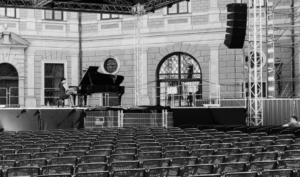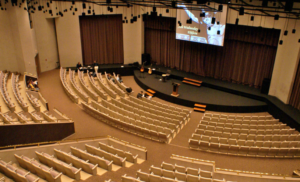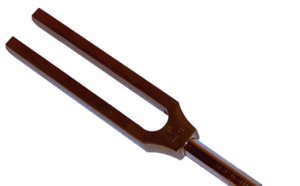Sound interference can be explained as the circumstance in which two sound waves travelling in the same medium get in the way of each other.
Interference of sound examples are mentioned as follow:-
Sound interference in gadgets
Sound interference can be found in an electronic gadget that we often use, which is a headphone.
Sound interference helps the headphone as, when sounds are played of opposite amplitude in the headphone, it cancels the noise coming from the surrounding.

This happens as the two waves from the headphone and surroundings undergo destructive interference and cancel each other. This helps us to hear sound with no interference.
Sound interference on piano
Playing the piano melodiously or non melodiously depend on the sound wave undergoing interference.
If we do not follow the piano notes and randomly or adjacent keys are tapped, we hear an unpleasant tune. This happens because of the superimposition of two sound waves produced, as the two waves, although similar, but not an identical frequency.

When two sound waves have the same frequencies match and superimpose, they perform constructive and destructive interference alternatively. Due to this, the beat is produced, which is either unpleasant to hear or melodious to hear.
Sound interference in jet air crafts
An air jet flying above us leaves behind a loud noise that fluctuates in nature.
This fluctuation of jet air crafts is due to the interference of sound waves. Suppose we take a two-engine jet. The sound waves produced by the two engines while flying is somewhat similar but do not have identical frequencies.

The sound produced by the two jet engines is heard to be loud and sometimes low in their intensity. This occurs as the sound wave interfere with each other path and undergo interference. They go under constructive and destructive interference alternatively. Due to this, a loud noise is produced at constructive, and low noise is produced at destructive points.
In this, the new wave of sound formed after superimposition is of average frequencies of the two later waves.
Sound interference in auditoriums
Sound waves are nothing but vibrations travelling in a medium.
We are able to hear different types of sound because of one of our senses organs, which is our ears. The vibration travels in a medium, say in air. When lands on ou ear. The outer ear trap’s sound vibration and the inner ear turns these vibrations into impulses. When it reaches our brain, we are able to hear different voices and sounds and also differentiate them.
Similarly, we hear when we visit any musical concerts in an auditorium where music is played, the sound waves created by the musicians or different gadgets strike the wall, and it is reflected back.
Suppose we assume that the auditorium hall is well designed acoustically. In that case, the sound waves which get reflected from the wall of the auditorium will undergo interference, and it will be a constructive one. Due to this constructive interference only, the auditoriums produce such a loud musical instrument and the musicians. However, if the sound waves from the auditorium undergo destructive interference, then the sound produced by the instruments will be muzzled. And the sound from musicians will below and come to deadened certainly.

Destructive interference in an auditorium is the issue. But it is of use in other areas. For example, a vehicle damper, is attached to cars, bikes, etc. The engines of these auto motives created a loud noise. But if the damper is attached to it, then the sound waves undergo a destructive interference, resulting in the dampening of sound waves. And reduces the sound as it cancels the noise.
Besides this, destructive interference is used in many more areas, such as headphones. It also helps reduce sound in a room, as a machine that can produce a sound that is out of phase to the noise in the room and cancels it out, resulting in low or no sound.
Sound interference in a fork
A tuning fork is a metal device that is in U shape. When a tuning fork is struck, it produces a sound of the same tone whenever struck.
When we strike a tuning fork and move it near our ears, we notice that the tuning fork’s sound is not constant. The sound produced varies between loud and soft sounds while moving the tuning fork. While moving it, the angle of constructive and destructive interference changes and produces this variation.
A tuning fork is also used by a pianist, as the tuning fork produces a sound of the same frequencies. The pianist first strikes the tuning fork and then play the piano keys.
Due to sound produced by the piano and tuning fork simultaneously, the sound frequencies are most likely to be aligned. If their frequency is aligned, the sound waves undergo both constructive and destructive interference.

During this playing of instruments, as time proceeds, the sound produced by both of the apparatus the sound varies between constructive and destructive interference. Suppose there is constructive interference between the sound waves of the tuning fork and sound produced by the piano. In that case, the average sound produced will be louder in comparison to the solely sound of the piano and tuning fork. However, if the sound waves undergo destructive interference, their collective sound will be softer compared to the individual sound produced by the piano and tuning fork.
Also Read:
- Radiation heat transfer examples
- Law of detachment examples
- Electric force examples
- Perfectly inelastic collision examples
- Sn1 examples detailed insights and facts
- Internal forces examples
- Elastic force examples
- Endothermic reaction examples
- Harmonic oscillator examples
- Tetrahedral molecule examples
I am Riya Pandey. I have completed Post Graduation in physics in 2021. Currently I am working as a Subject Matter Expert in Physics for Lambdageeks. I try to explain Physics subject easily understandable in simple way.